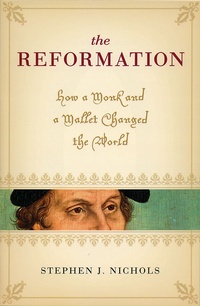Stephen Nichols: The Reformation
 Stephen J. Nichols, The Reformation: How a Monk and a Mallet Changed the World (Wheaton: Crossway Books, 2007), 159 pages, ISBN 9781581348293.
Stephen J. Nichols, The Reformation: How a Monk and a Mallet Changed the World (Wheaton: Crossway Books, 2007), 159 pages, ISBN 9781581348293.
Stephen J. Nichols has written a book on church history that is interesting, informative, and entertaining. The book is titled, The Reformation: How a Monk and a Mallet Changed the World. According to Nichols, the book is developed on two ideas: “First, the Reformation matters. Second, history can be fun” (13).
Using Martin Luther as his starting point, Nichols describes how the Protestant Reformation began, and its impact on future generations. He writes that when Luther took a mallet on Oct. 31, 1517, and nailed his Ninety-Five Theses on the church door in Wittenberg, he started a movement that would spread across the world. He writes: “Luther’s act gave birth to the Protestant church, now nearly 600 million members strong. Luther’s act also brought the world out of medieval times and into the modern age” (11). Nichols argues that what Luther and the other Reformers did in terms of ministry and church doctrine provide lessons for the contemporary church.
Nichols holds a Ph.D. from Westminster Theological Seminary. A professor at Lancaster Bible College and Graduate School, he has written a number of books, including Heaven on Earth, and The Pages of Church History. He is also the author of An Absolute Sort of Certainty: The Holy Spirit and the Apologetics of Jonathan Edwards.

Stephen J. Nichols was named the new President of Reformation Bible College and Chief Academic Officer of Ligonier Ministries in March, 2014. ReligionNews.com press release
In The Reformation, Nichols presents his work in eight chapters. In his first chapter, he explains why the Reformation matters today. This chapter is followed by a look at Martin Luther and the German Reformation. The next chapter focuses on Ulrich Zwingli and the Swiss Reformation. The chapters that follow feature the Anabaptists, John Calvin and the Swiss Reformation, the Anglicans and the British Reformation, the Puritans and the British Reformation, and women and the Reformation.
In the Appendix, Nichols includes a collection of original writings under the heading, “In Their Own Words: Selections from Documents of the Reformation.” Here, he includes important texts of the Reformation such as Luther’s Ninety-Five Theses, and the works of John Calvin. This section also contains the confessions of the Reformation, the catechisms of the Reformation, and the prayers of the Reformation.
The final section of the book includes a “Reformation Scorecard.” It is a chart that presents an overview of the entire book. Among other things, the chart features the respective regions of the Reformation, the key players in each area, as well as the significant events and writings that occurred. A mere glance at this chart allows readers to get a quick overview of what happened during the Reformation.
The Reformers were known for their stand on the Word of God as the final authority, and the doctrine of justification by faith alone in Christ alone. In showing why the Reformation matters today, Nichols reminds readers of the Bible five important doctrines that became the foundation of the Reformation. In his first chapter, he discusses:
(1) “Sola Scriptura,” which means, “Scripture alone.” This is the view that Scripture is the final and sole authority for the church.
Category: Church History, Summer 2011


